The Corsair Neutron NX500 (400GB) PCIe SSD Review: Big Card, Big Pricetag
by Billy Tallis on August 16, 2017 10:00 AM ESTAnandTech Storage Bench - The Destroyer
The Destroyer is an extremely long test replicating the access patterns of very IO-intensive desktop usage. A detailed breakdown can be found in this article. Like real-world usage, the drives do get the occasional break that allows for some background garbage collection and flushing caches, but those idle times are limited to 25ms so that it doesn't take all week to run the test. These AnandTech Storage Bench (ATSB) tests do not involve running the actual applications that generated the workloads, so the scores are relatively insensitive to changes in CPU performance and RAM from our new testbed, but the jump to a newer version of Windows and the newer storage drivers can have an impact.
We quantify performance on this test by reporting the drive's average data throughput, the average latency of the I/O operations, and the total energy used by the drive over the course of the test.
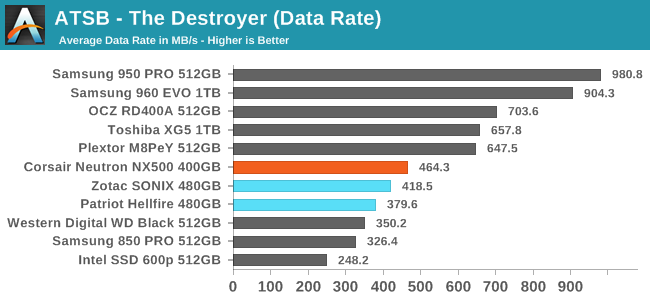
The NX500's average data rate on The Destroyer is clearly faster than the other Phison E7 drives, but still far slower than competing MLC NVMe SSDs. The Plextor M8Pe and OCZ RD400 offer much higher performance from the same 15nm MLC NAND.


The NX500 offers the best average latency on The Destroyer among the Phison E7 drives. The 99th percentile latencies are quite different, with the Zotac SONIX outperforming the Corsair NX500, while the Patriot Hellfire is clearly having problems keeping latency under control.
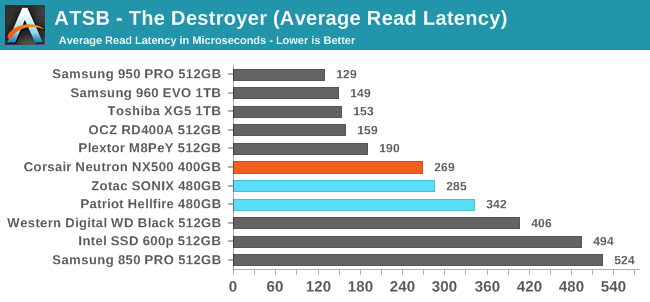
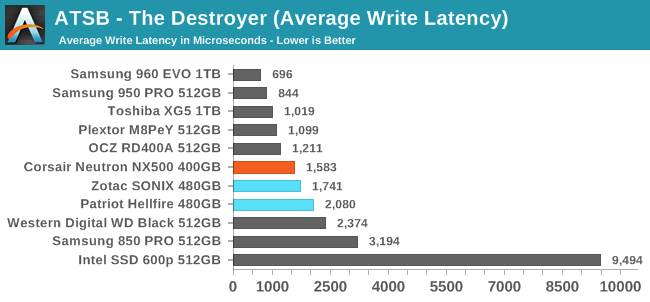
Splitting the average latency by reads and writes doesn't reveal any surprises among the Phison drives, but there are a few differences in the rankings of the other drives. The Intel 600p stands out as the only drive that has a real problem with write latency even in the average case.
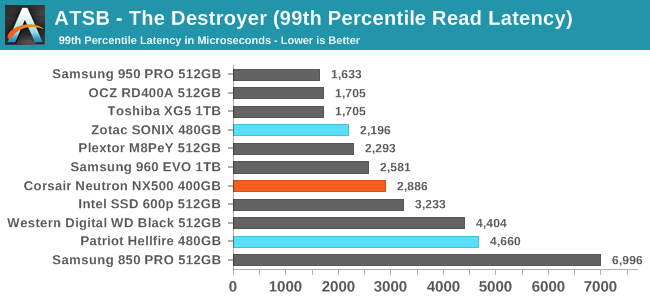

The 99th percentile latencies show interesting differences between the Phison drives in how they handle reads and writes. The Zotac SONIX has the best 99th percentile read latency among the Phison E7 drives and places pretty well among the overall field of competitors. The Corsair Neutron NX500 is substantially slower, while the Patriot Hellfire's 99th percentile read latency is worse than any other NVMe drive on this chart.
The 99th percentile write latencies are all rather slow on the Phison E7 drives, but the Corsair NX500 is the best of the three at keeping write latency low. This is to be expected given the greater spare area the NX500 has to work with, but the impact of that much extra overprovisioning on write QoS ought to be more significant.
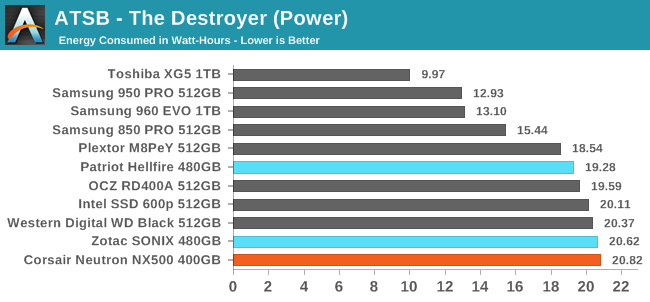
The Corsair Neutron NX500 and Zotac SONIX are at a bit of a disadvantage compared to the M.2 drives here since the NX500 and SONIX add-in cards draw power from the 12V supply and thus include more voltage regulation circuitry than the M.2 SSDs. The NX500 is further disadvantaged by having more DRAM to power. However, even the Patriot Hellfire M.2 can't come close to the 3D NAND SSDs from Samsung and Toshiba. Surprisingly, the most efficient planar NAND SSD in this bunch is the Plextor M8PeY, which was flashing its red LEDs during the entire test.










45 Comments
View All Comments
Exodite - Wednesday, August 16, 2017 - link
I'm looking forward to the day I can read a SSD review and not come away thinking "...or just buy a Samsung".Not that I begrudge them top spot, they've clearly put the work into it, but as consumers we'd be better served if at least /someone/ else were competing on, like, any metric.
Ej24 - Wednesday, August 16, 2017 - link
Crucial used to be in the game back when Sata SSD's were king, then they just never released another MLC drive, nor any consumer nvme drives. So yeah, Samsung is definitely unchallenged now. Though that Toshiba xg5 kept up well in the destroyer benchmark.coolhardware - Wednesday, August 16, 2017 - link
Agreed. Samsung has been at the top for so long it is just boring.Kudos to Samsung though for making some fast and reliable SSDs at a reasonable price point.
Lolimaster - Wednesday, August 16, 2017 - link
I think we got more chances to see GloFo AMD branded SSD better than the 850 than waiting for the known competitors.Samus - Wednesday, August 16, 2017 - link
Crucial is still in the game. They just can't compete with Samsung on performance. Nobody can.But in my experience, Crucial/Micron drives are slightly more reliable that Samsung (obviously excusing the flawed 840\840 EVO) especially in regard to power loss scenarios. That's why you continue to see more Micron drives in enterprise and business PC's than any other brand (except perhaps Sandisk, in which case they are often the same Marvell controller so the differentiating factor comes down to firmware and in-flight data protection)
It's really hard to consider anything else when looking at "new" drives. Samsung and Crucial/Micron are really at the top. Sandisk is decent, but not cost competitive at the high end, and OCZ's has had some good drives for the price lately, but why gamble?
And if you are looking for cheap MLC drives, older Intel drives are still the best bet. I still have a soft spot for SSD320's and SSD710's if you can live with the 3Gbps interface they are bulletproof and incredibly cheap on fleabay.
DigitalFreak - Wednesday, August 16, 2017 - link
"That's why you continue to see more Micron drives in enterprise and business PC's than any other brand (except perhaps Sandisk, in which case they are often the same Marvell controller so the differentiating factor comes down to firmware and in-flight data protection)"Maybe it's the particular vendor, but the Dell and Cisco equipment I deal with in both the server and desktop space use mainly Samsung, with some Toshiba XG series on the client side.
tipoo - Wednesday, August 16, 2017 - link
It's maybe ironic the only one challenging them on SSD speed isn't selling SSDs outside their own systems, i.e the last custom Apple SSD controller.tipoo - Wednesday, August 16, 2017 - link
Actually I'd love to see that put through this suite.extide - Wednesday, August 16, 2017 - link
Well at least I can be satisfied knowing I made a good investment buying my 1TB 960 EVO -- heck I think I paid around $400 - $450 or so for it -- cheaper than the 800GB version of this. It makes reviews boring but at the same time it sucks spending good money on something and then seeing something cheaper and faster released shortly after, although I do agree that we need to see some competition.beginner99 - Thursday, August 17, 2017 - link
Yeah. Perfromance is one thing but price another and this drive is clearly overpriced. If you want me to use a pcie-card ssd you better deliver something special but this fails.What's missing is a strady-state bench. First the large spare area gets praised but then no steady-state data? IMHO that is usually the most important aspect of the review, the actual performance the drive will have not some "marketing" numbers.